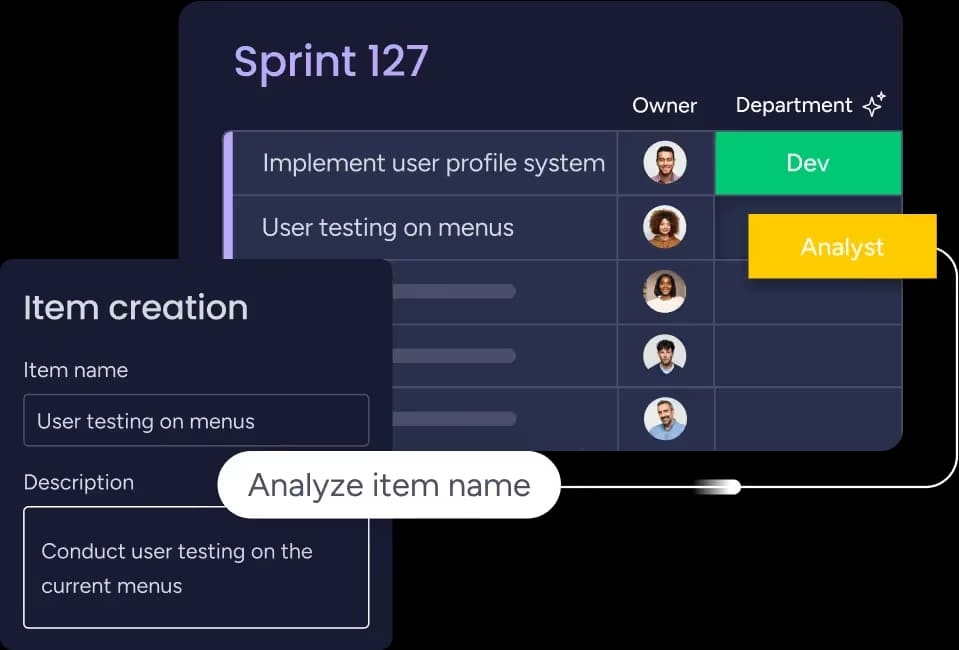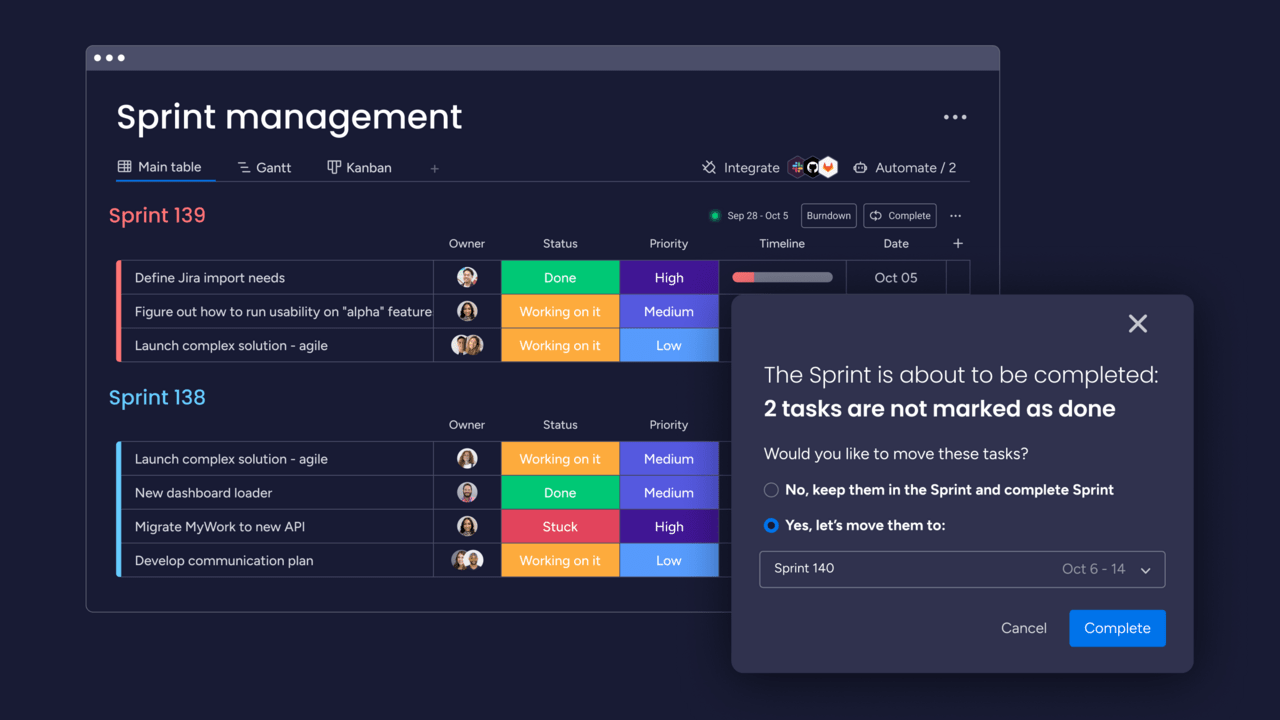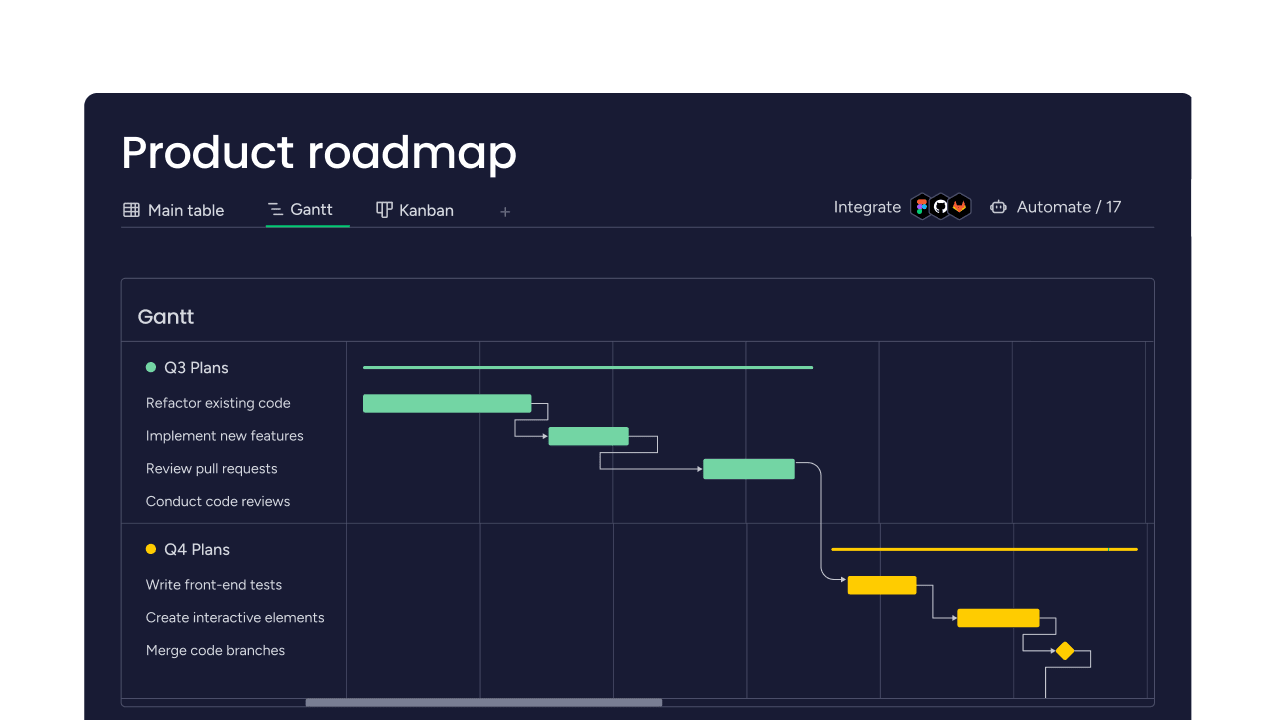True momentum in development is born from alignment, not just speed. While teams often measure success by shipping velocity, building the wrong product faster wastes resources and time. Product strategy provides the essential focus, acting as the high-level plan that connects every feature, bug fix, and technical decision to your company’s biggest goals.
A strong strategy answers three core questions: what problem you are solving, who you are solving it for, and how your solution is truly unique. This focus allows organizations to prioritize high-impact initiatives and make critical investment decisions with confidence.
This practical post outlines the framework for building and executing a winning product strategy, covering its core benefits, essential components, and the steps required to link high-level plans directly to execution, ensuring alignment from the roadmap to the code.
By the end, you will possess a complete methodology for translating your strategic vision into daily, successful product delivery.
Key takeaways
- Strategy defines direction: product strategy connects your vision to execution by defining what problem you solve, who has it, and how your solution is unique.
- Accelerate value delivery: a clear strategy eliminates ambiguity and endless debates, accelerating time to market and optimizing resources by focusing teams on high-impact work.
- Build your strategy in 7 steps: follow a structured framework: research the market, define customers, articulate value, set objectives, design initiatives, create roadmaps, and establish metrics.
- Align execution to strategy: platforms like monday dev unite product, engineering, and business teams with customizable workflows and real-time visibility, connecting planning directly to daily execution.
- Adapt continuously: measure and evolve your strategy through quarterly tactical reviews and annual strategic assessments, balancing long-term initiatives with quick-win investments.
What is product strategy?
A strong product strategy is a high-level plan that defines your product goals and how you’ll achieve them. It answers three key questions: what problem you’re solving, who has this problem, and how you’ll solve it uniquely.
Product strategy serves as your product roadmap for making smart product decisions. It helps you choose which features to build, which customers to target, and how product positioning can give you an edge over competitors.
Product strategy vs product vision
Product vision is where you want to go, your aspirational future state. Product strategy is how you’ll get there, your actionable plan with specific steps and milestones.
Here’s how they work together:
- Vision: “make project collaboration effortless for every team”.
- Strategy: target mid-market software teams first, build integrations with their existing tools, and expand to enterprise customers within 18 months.
Your vision inspires; your strategy executes.
How product strategy drives business success
Without product strategy or a clear product plan, teams build features randomly, chase every customer request, and waste resources on low-impact work. Clear strategy creates focus and alignment across your entire organization.
When everyone understands the strategy, decisions happen faster. Teams stop debating direction and start executing toward shared goals.
5 core benefits of product strategy
A strong product strategy transforms how your organization operates. These benefits listed below directly impact your bottom line and competitive position:
Accelerate time to market
Clear strategy eliminates the endless debates that slow down development. When priorities are defined upfront, teams ship features faster and respond to market changes quickly.
You’ll see this acceleration in two key areas:
- Faster decision-making: teams evaluate options against strategic criteria instead of escalating every choice.
- Reduced scope creep: clear boundaries prevent features from expanding beyond their original intent.
Optimize resource allocation
Strategy acts as a filter for investment decisions. You can quickly assess whether new opportunities deserve resources or distract from core objectives.
This focused allocation delivers measurable results. Teams concentrate effort on high-impact initiatives rather than spreading themselves thin across competing priorities.
Strengthen team alignment
When product, engineering, and business teams operate under a shared strategy, organizational friction is significantly reduced. Marketing gains clarity on which features to prioritize in messaging, engineering establishes unambiguous architectural priorities, and leadership ensures consistent decision-making.
Improve decision making
Strategy provides a framework for evaluating trade-offs. Instead of relying on opinions or politics, teams assess options against clear criteria.
This systematic approach builds confidence. Teams know their choices support larger objectives, which reduces second-guessing and enables faster execution.
Increase product success rates
Products built with strategic focus solve real problems that customers will pay to fix. Strategy fosters product discovery and validation before significant investment, reducing the risk of building something nobody wants.

Essential components of effective product strategy
Every winning product strategy contains five core components that work together seamlessly. Be careful not to miss or discard any of these because it can weaken your entire approach:
Market vision and opportunity
Market vision defines the problem space you’re addressing and the size of the opportunity. This goes beyond surface-level market research to understand deep customer pain points and competitive dynamics.
Strong market vision includes:
- Problem identification: what specific challenges do customers face?
- Market sizing: how many potential customers share this problem?
- Timing assessment: why is now the right time for your solution?
Target customer definition
Generic targeting leads to generic products. Specific customer definition drives every other strategic decision.
Go beyond demographics to understand:
- Jobs-to-be-done: what are customers trying to accomplish?
- Current solutions: what alternatives do they use today?
- Switching triggers: what would make them change solutions?
Unique value proposition
Your value proposition explains why customers should choose you over alternatives. It connects their specific needs to your unique capabilities and enables product differentiation in a crowded market.
Effective value propositions are specific and measurable. Instead of claiming to be “easier,” explain exactly how you save time or reduce complexity.
Strategic goals and objectives
Goals translate opportunity into measurable outcomes. They should connect product success directly to business results, often by leveraging OKR product management.
Set objectives that are:
- Specific: clear targets everyone understands.
- Time-bound: defined deadlines for achievement.
- Business-aligned: tied to revenue, retention, or market share.
Success metrics and KPIs
Metrics validate whether your strategy works. Combine leading indicators (early signals) with lagging indicators (final results) for complete visibility.
Focus on metrics that measure outcomes, not just activity. Track customer value delivered, not just features shipped.
4 types of product strategies that win
Different strategic approaches succeed in different contexts. Understanding these patterns helps you choose the right strategy for your organizational goals:
1. Product-led growth
Product-led growth uses the product itself to acquire and expand customers. Users can sign up, experience value, and upgrade without talking to sales.
This strategy works when:
- Quick value delivery: users see benefits within minutes.
- Viral mechanics: natural reasons for users to invite others.
- Self-service model: customers can succeed without hand-holding.
2. Platform strategy
Platform strategies create ecosystems where others build value on your foundation. You provide infrastructure; partners and developers extend capabilities.
Success requires attracting both sides of the market — those who build on the platform and those who use what’s built. Dedicated platforms like monday dev exemplify this approach by enabling teams to customize workflows while maintaining a stable core platform.
3. Differentiation strategy
Differentiation means offering unique capabilities that customers value and competitors can’t easily copy. This goes beyond features to include user experience, integrations, or business model. Ongoing product innovation is also essential to outpacing competitors.
Sustainable differentiation requires deep customer understanding and excellent execution on complex capabilities.
4. Market expansion strategy
Finally, expansion strategies grow by entering new customer segments or geographic markets. You leverage existing capabilities while adapting to new contexts.
Successful expansion balances standardization with localization. Core value remains consistent while packaging and positioning adapt to new markets.

How to build a product strategy: 7 simple steps
Effective product development starts with a strategy built on evidence, prioritization, and aligned decision-making. The steps below outline a simple, repeatable framework for turning research and insights into a plan teams can act on with purpose.
Step 1: research your market and competitors
Start with comprehensive research using multiple sources. Interview customers directly to understand their workflows and pain points. Analyze competitors to identify gaps and opportunities.
Document findings in a format stakeholders can review and reference. Focus on problems customers actively try to solve, not just preferences they express.
Step 2: define your target customers
Use research to identify specific segments worth pursuing. Prioritize based on market size, growth potential, and your ability to serve them uniquely.
Create detailed personas that include:
- Current workflows: how they solve problems today.
- Decision criteria: what matters when choosing solutions.
- Success metrics: how they measure their own success.
Step 3: articulate your value proposition
Connect customer needs to your unique capabilities. Explain why your solution delivers outcomes competitors can’t match.
Test your value proposition with real customers. If they don’t immediately understand the benefit, refine your message until it resonates.
Step 4: set strategic objectives
Transform opportunity into specific, measurable goals. Connect product metrics to business outcomes for clear accountability.
Balance short-term wins with long-term building. Quick victories maintain momentum while you invest in sustainable advantages.
Step 5: design product initiatives
Break objectives into major initiatives that advance your strategy. Each initiative should be substantial enough to move metrics while remaining achievable.
Sequence initiatives to build capabilities progressively. Early wins create foundation for later, more complex achievements.
Step 6: create your strategy roadmap
Visualize initiatives over time in a format that communicates to your audience. Executives need high-level timelines; teams need detailed planning views.
Utilizing product roadmap software can ensure your roadmap clearly shows how initiatives support strategic objectives. Include milestones and decision points for course corrections.
Step 7: establish measurement framework
Define metrics that track progress toward objectives. Set up dashboards and review cycles to monitor performance and adjust as needed.
Remember that strategy requires ongoing refinement. Market feedback and results should inform regular updates to your approach.
Product strategy examples from leading companies
Real examples show how successful companies apply strategic thinking. These cases we’ve picked out below demonstrate the connection between strategy choices and business outcomes.
B2B software success stories
- Salesforce: built a platform ecosystem after establishing CRM leadership. Their strategy created network effects — the more apps on the platform, the more valuable it became for customers.
- Atlassian: pursued product-led growth with tools teams could adopt without IT approval. This bottom-up strategy reduced sales costs while achieving rapid expansion.
Consumer product innovations
- Apple: differentiates through integrated experiences across devices. Their strategy focuses on ecosystem lock-in: each Apple product works best with other Apple products.
- Spotify: expanded from music streaming to podcasts and audiobooks. This market expansion strategy leveraged their existing infrastructure while accessing new revenue streams.
Platform strategy wins
- Shopify: enables anyone to start an online store, then profits from their success through transaction fees and app marketplace sales. Their platform strategy aligns their growth with merchant growth.
- monday dev: takes a similar approach by providing a flexible foundation that teams customize for their specific needs. The platform grows more valuable as teams build more workflows and integrations.

How to connect product strategy to execution
A strategy becomes meaningful only when it guides what teams actually deliver. Bridging the gap between strategic intent and execution helps ensure every initiative, feature, and trade-off contributes to the bigger picture.
From strategy to product roadmap
Strategic initiatives become roadmap themes. Each feature should clearly support strategic objectives rather than existing in isolation.
Effective roadmaps balance strategic work with operational necessities. Include time for technical debt, bug fixes, and infrastructure improvements.
Prioritization frameworks that work
Use systematic methods to evaluate opportunities. Popular frameworks include:
- RICE scoring: Reach × Impact × Confidence ÷ Effort.
- Value vs. Effort matrix: plot initiatives by expected value and required effort.
- MoSCoW method: categorize as Must have, Should have, Could have, Won’t have.
Choose frameworks simple enough for consistent use but sophisticated enough for complex decisions.
Managing trade-offs and constraints
Strategy helps navigate difficult choices. When resources are limited, strategic criteria guide what to pursue and what to postpone.
Distinguish between strategic pivots (major direction changes) and tactical adjustments (execution modifications). Most challenges require tactical adjustments, not strategic overhauls.
Measuring and adapting your product strategy
Strategy isn’t static — it evolves based on market feedback and results. Build measurement and adaptation into your product lifecycle management approach.
Key performance indicators to track
Connect KPIs directly to strategic objectives. If your strategy focuses on market expansion, track metrics like new segment penetration and geographic growth.
Balance leading and lagging indicators:
- Leading: user activation, feature adoption, engagement rates.
- Lagging: revenue growth, market share, customer lifetime value.
Strategy review cycles
Schedule regular reviews that match your business rhythm. Quarterly reviews work for tactical adjustments; annual reviews enable comprehensive evaluation.
Include diverse stakeholders in reviews. Different perspectives reveal blind spots and ensure broad organizational alignment.
When and how to pivot
Know the difference between persistence and stubbornness. Warning signs that indicate pivot consideration include consistent underperformance despite tactical adjustments, fundamental market shifts, or new competitive threats.
Successful pivots maintain core strengths while redirecting toward new opportunities. Communicate changes clearly to maintain team confidence.

"monday dev empowered us to optimize our GTM approach, resulting in faster, more dependable deliveries"
Steven Hamrell | Director of Product Management
"monday dev empowers us to manage the entire development process on one platform so we can speed up product delivery and improve customer satisfaction"
Mitchel Hudson | Head of Technology
"We're operating in an open, deep trusting, transparent environment with no silos of information. It's about completely opening access to everyone who needs it."
Alan Schmoll | Executive Vice President, Vistra PlatformProduct strategy trends transforming 2026
Product strategy is entering a period of rapid transformation: new technologies, shifting customer expectations, and tighter cross-functional alignment are reshaping how leading companies make decisions and bring products to market.
These emerging trends are defining what effective strategy looks like in 2026 and beyond.
AI-powered strategy development
AI accelerates market research and competitive analysis. According to a PwC survey, nearly half (49%) of tech leaders report that AI is already fully integrated into strategy, allowing teams to process vast amounts of customer feedback, identify patterns, and spot opportunities faster than ever.
Cross-functional strategy integration
Product strategy now involves all departments from the start. Marketing, sales, and customer success contribute to strategy development rather than just executing predetermined plans.
This integration creates more comprehensive strategies and smoother execution. For example, one McKinsey report on tangible cross-functional collaboration found that when teams worked together, first-time-right delivery increased from 65% to over 80% and customer satisfaction went up, proving that teams who master this outperform those working in silos.
How monday dev powers modern product strategy
As a product management software, the intuitive and sophisticated monday dev addresses core product strategy challenges with a flexible platform that grows with your team. Connect strategic planning with daily execution while maintaining visibility across all initiatives.
Key capabilities for strategic teams:
- Customizable workflows: build processes that match your strategic framework, whether using OKRs, roadmaps, or custom approaches
- Cross-team alignment: unite product, engineering, and business teams with shared visibility into strategic progress
- Real-time dashboards: monitor strategic KPIs and initiative progress with visual boards that update automatically as work moves forward
- Sprint planning integration: connect high-level strategic goals directly to sprint work, ensuring every development cycle advances your product strategy
- Roadmap visualization: create timeline views that show how initiatives map to strategic objectives, making it easy to communicate plans to stakeholders
- Scalable execution: track initiatives from high-level strategy down to individual items without switching platforms
- Automated workflows: set up triggers and notifications that keep strategic work moving, from approval processes to status updates
- Integration ecosystem: connect with tools your team already uses, from GitHub and Jira to Slack and Figma, creating a unified workspace for strategic execution
Ready to transform your product strategy into results? Try monday dev today.
Frequently asked questions
What is the difference between product strategy and product management?
The difference between product strategy and product management is that product strategy defines what to build and why — it sets direction and priorities. Product management focuses on how to build and deliver — it handles execution through roadmaps, feature specifications, and team coordination. Strategy provides the framework; management ensures daily progress within that framework.
How often should companies review their product strategy?
Companies should conduct quarterly tactical reviews and annual strategic reviews. Quarterly reviews assess progress and make minor adjustments. Annual reviews examine fundamental assumptions and market changes. Fast-moving markets may require monthly check-ins, while stable industries can extend review cycles.
Can small startups benefit from formal product strategy?
Small startups gain significant advantages from product strategy because it focuses limited resources on high-impact opportunities. Strategy prevents feature sprawl and ensures team alignment. Startup strategies can be simpler than enterprise versions but should still include target customers, value proposition, and success metrics.
How does product strategy differ for B2B versus B2C products?
B2B product strategy emphasizes solving business problems with clear ROI for multiple stakeholders. B2C strategy focuses on user experience and rapid adoption. B2B involves longer sales cycles and integration requirements, while B2C prioritizes viral growth and engagement metrics.
What role does customer feedback play in product strategy development?
Customer feedback validates strategic assumptions and reveals unmet needs. Direct feedback through interviews uncovers workflow pain points. Indirect feedback through usage data shows actual behavior patterns. Balance customer input with market vision — customers explain current problems but may not envision future solutions.
How do you balance short-term wins with long-term strategic goals?
Allocate 70% of resources to core strategic initiatives and 30% to quick wins. Short-term victories build momentum and validate direction. Long-term investments create sustainable advantages. Ensure quick wins align with strategic direction rather than creating distractions from main objectives.
 Get started
Get started 


